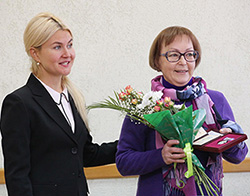Anna V. Shestopalova
Doctor of physical and mathematical sciences, Professor, senior researcher
Born on May 13, 1958. In 1980 she graduated from Kharkiv State University and in 1983 finished the postgraduate
studies at its Department of Molecular and Applied Biophysics, Radiophysics Faculty
The field of scientific interests is connected with studying the mechanisms of interactions in molecular systems, namely: biomacromolecules (or their components and derivatives) – water – ions – biologically active agents and structural bioinformatics. The main methods used in the investigations are quantum chemistry, Monte Carlo simulation, molecular docking and molecular dynamics applied to study the associates of the biomolecules, their components and biological active compounds (anticancer antibiotics and their derivatives) in nonpolar and polar solvents, especially in water, conformational changes of biopolymers depending on relative humidity; the interactions of nucleic acids and their components with drugs and proteins; methods of structural bioinformatics.
Ph.D. (Biophysics) Thesis: “Caffeine hydration and its interaction with system DNA-water” (Tbilisi, Institute for Physics Georgian Academy of Sciences, Georgia, 1987).
Dr.Sci. (Biophysics) Thesis: “Molecular mechanisms of hydration and complex formation of nucleic acids and biological active compounds” (V. N. Karazin Kharkiv National University, 2007).
Main scientific results:
- The processes of aggregation in aqueous solutions of biologically active aromatic compounds were studied using experimental methods (EHF dielectrometry, IR spectroscopy and piezogravimetry) and by computer simulations (Monte Carlo method and molecular dynamics);
- The processes of formation of hydration environment of components and fragments of nucleic acids and their complexes with biologically active substances were investigated using experimental methods (UV spectroscopy, IR spectroscopy and piezogravimetry) and by computer simulation (Monte Carlo, molecular docking, quantum chemistry and molecular dynamics methods);
- The mechanisms of molecular recognition in protein – nucleic acid complexes were studied using the methods of structural bioinformatics.
Anna Shestopalova is the author and co-author of 126 scientific publications, including 40 articles and 3 monographs.
Selected publications:
- Шестопалова А.В., Кашпур В.А., Малеев В.Я. Гидратация кофеина в растворах по данным СВЧ-диэлектрометрии // ДАН УССР. – 1984. – серия Б, №7. – С.79-82.
- Шестопалова А.В., Данилов В.И., Малеев В.Я. Природа стопкообразования молекул кофеина в воде: изучение методом Монте Карло // ДАН СССР. – 1985. – 282, №4. – С.1000-1003.
- Danilov V.I., Shestopalova A.V. Hydrophobic effect in biological associates: a Monte Carlo simulation of caffeine molecules stacking // Int. J. Quant. Chem.- 1989. – XXXV, N – Р.103-112.
- Shestopalova A.V. Interaction of caffeine molecular associates with water: theory and experiment // Croatica Chem.Acta. – 1989. – 62, N 4. – Р.825-834.
- Maleev V., Semenov M., Kashpur V., Bolbukh T., Shestopalova A., Anishchenko D. Structure and hydration of polycytidylic acid from the data of infrared spectroscopy, EHF dielectrometry and computer modeling // J. Mol.Structure. – 2002. – 605, N1. – Р.51-61.
- Gasan A.I., Virnik K.M, Shestopalova A.V., Maleev V.I. Dynamic properties of water bound to matrices of natural DNA and model complexes // Biofizika. – – 47, №2. – Р.245-252.
- Virnik K.M., Gasan A.I., Maleev V.Ia.,Shestopalova A.V. Energetics of hydration of nucleic acids with various nucleotide composition // Biofizika. – – 47, №3. – Р. 420-426.
- Shestopalova A.V. Hydration of nucleic acids components in dependence of nucleotide composition and relative humidity: a Monte Carlo simulation // European Phys. J. D. – 2002. – 20, №1. – Р.331-337.
- Berezniak E.G., Semenov M.A., Bol’bukh T.V., Dukhopel’nikov E.V., Shestopalova A.V., Maleev V.Ia. Study of effect of water on the interaction of DNA and actinocin derivatives with various aminoalkyl chain length by infrared spectrophotometry and computer modeling // Biofizika. – 2002. – 47, №6. – Р.1005-1014.
- Maleev V.Ya., Semenov M.A., Kruglova E.B., Bolbukh T.V, Gasan A.I., Bereznyak E.G., Shestopalova A.V. Spectroscopic and calorimetric study of DNA interaction with a new series of actinocin derivatives // J. Mol. Structure. – 2003. – 645, №1. – Р.145-158.
- Miroshnychenko K.V., Shestopalova A.V. Flexible docking of DNA fragments and actinocin derivatives // Molecular Simulation. – 2005. – 31, N – P. 567–574.
- Shestopalova A.V. Computer simulation of the association of caffeine and actinocin derivatives in aqueous solutions // Biofizika. – 2006. – 51, № 3. – Р.389-401.
- Shestopalova A.V. The investigation of the association of caffeine and actinocin derivatives in aqueous solution: A molecular dynamics simulation // J. Mol. Liquids. – 2006. – 127, N1-3. -113-117.
- Miroshnychenko K.V., Shestopalova A.V. Molecular dynamics simulation of different helical forms of polyribocytidilic acids // Biophysical Bulletin. – 2008. – 21 (2). – P.5-18.
- Tkachenko M. Y., Boryskina O. P., Shestopalova A. V., Tolstorukov M. Y.ProtNA-ASA: Protein-nucleic acid structural database with information on accessible surface area // Int. J. Quant. Chem. – 2010. – 110, №1. – Р. 230–232.
- Miroshnychenko K.V., Shestopalova A.V. The Effect of Drug-DNA Interactions on the Intercalation Site Formation // Int. J. Quant. Chem. – 2010. – 110, №1. – Р.161-176.
- Boryskina O.P., Tkachenko M.Yu., Shestopalova A.V. Variability of DNA structure and protein-nucleic acid reconginition // Cell. – 2010. – 26, №5. – Р.360-372.
- Boryskina O. P., Tkachenko M. Yu., Shestopalova A. V. Protein-DNA complexes: specificity and DNA readout mechanisms // Cell. – 2011. – 27, №1. – Р.3-16.
- Semenov M.A., Blyzniuk Iu.N., Bolbukh T.V., Shestopalova A.V., Evstigneev M.P., Maleev V.Ya. Intermolecular hydrogen bonds in hetero-complexes of biologically active aromatic molecules probed by the methods of vibrational spectroscopy // Spectrochimica Acta Part A: Molecular and Biomolecular Spectroscopy. – -V. 95. – p. 224–229.
- Pesina D. A., Kashpur V. A., Khorunzhaya O. V., Shestopalova A. Hydration of complexes of chlorophyllin with human and bovine serum albumin investigated by differential EHF dielectrometry // Bioph Bul. 2013. – N. 30(2). – P. 5-14.
- Zhitnikova M.Y., Boryskina O.P., Shestopalova A.V. Sequence-specific transitions of the torsion angle gamma change the polar-hydrophobic profile of the DNA grooves: implication for indirect protein-DNA recognition // Biomol. Struct. Dyn. – 2014. – V.32. – N 10. – pp. 1670-1685.
- Evstigneev M.P., Shestopalova A.V. Structure, Thermodynamics and Energetics of Drug-DNA Interactions: Computer Modeling and Experiment, pp.21-58, In: Application of Computational Techniques in Pharmacy and Medicine; Series: Challenges and Advances in Computational Chemistry and Physics, Vol. 17; Gorb, Leonid, Kuz’min, Victor, Muratov, Eugene (Eds.), 2014, XIII, 550 p.; ISBN: 978-94-017-9256-1 (Print) 978-94-017-9257-8 (Online).
- Шестопалова А. В., Житникова М.Ю., Борискина Е.П. Полиморфизм ДНК и проблема белково-нуклеинового узнавания: монография. — LAP: Lambert Academic Publishing, Saarbrucken, Germany, 2014-03-25, 112 с., ISBN 978-3-659-30140-7.
Awards: Diploma of Presidium of Academy of Sciences of Ukraine, 2013.
Order of Princess Olga III degree, 2018 “For a significant personal contribution to the development of national science, strengthening the scientific and technical potential of Ukraine, many years of conscientious work and high professionalism”
Anna Shestopalova is the professor of the Department of Molecular and Medical Physics of Radiophysics, Biomedical Electronics and Computer Systems Faculty of V. N. Karazin National University. She prepared and gave lectures on courses “Physics of biopolymers”, “Biophysics of a man”, “The human genome”. Currently teaches courses “General biophysics. Molecular biophysics” and “Computer analysis of the biomolecular structures”.


